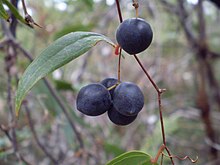|
Smilax glyciphylla
Smilax glyciphylla, the sweet sarsaparilla, is a dioecious climber native to eastern Australia. It is widespread in rainforest, sclerophyll forest and woodland; mainly in coastal regions. The leaves are distinctly three-veined with a glaucous under-surface, lanceolate, 4–10 cm long by 1.5–4 cm wide. Coiling tendrils are up to 8 cm long. The globose berries are 5–8 mm in diameter, black with a singular seed.[1] UsesThe fruit is edible. The sweet flavoured leaves are used medicinally[2] by Indigenous people and non-Indigenous colonists, including as a tea substitute.[3] It was used medicinally in the earliest days of the colony of Port Jackson for treating scurvy, coughs and chest complaints. In correspondence to England in November 1788, Dennis Considen wrote: "I have sent you some of the sweet tea of this country which I recommended and is generally used by the marines and convicts as such it is a fair antiscorbutic as well as a substitute for tea which is more costly."[4] It was recommended as a tea alternative, tonic and antiscorbutic, and was still being traded at least up until the late 19th century by Sydney herbalists.[5] It is claimed to have similar properties to Jamaican sarsaparilla, Smilax regelii. The leaves, stems, and flowers contain the glycoside glyciphyllin, which has a bitter-sweet taste and may be the active medicinal component.[6][7][8] Recent research shows that S. glyciphylla has antioxidant activity.[9] GalleryImages of Smilax glyciphylla References
|
||||||||||||||||||||||||||

